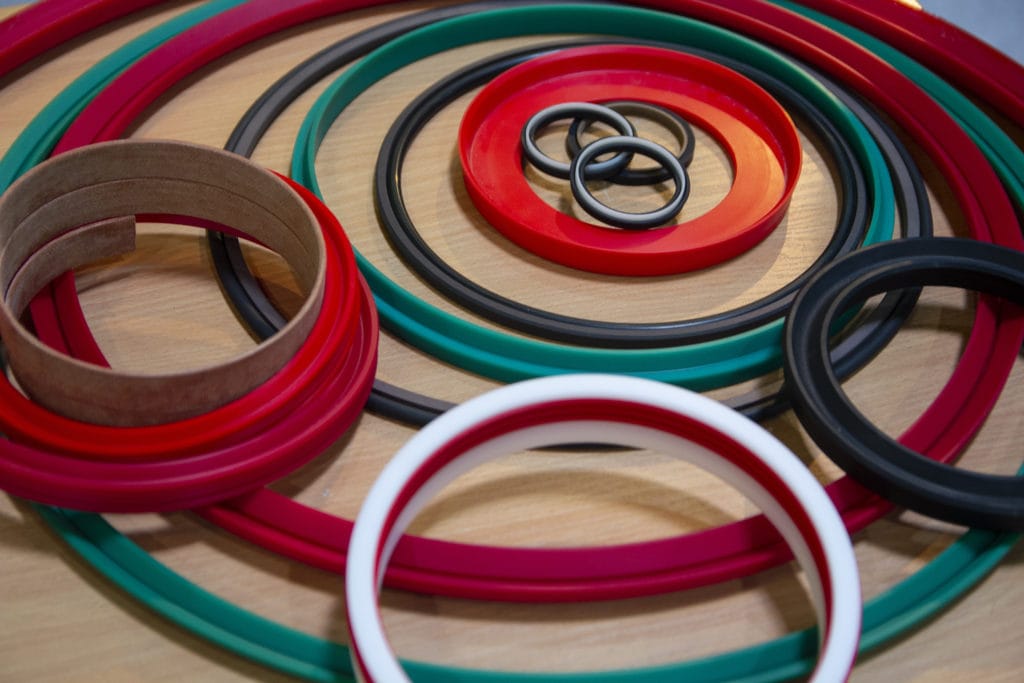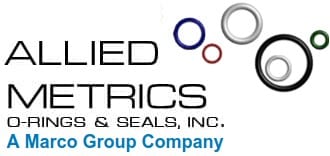An O-ring, also known as a packing or a toric joint, is a mechanical gasket in the shape of a torus, a circular gasket with a hole through the middle to facilitate the flow of fluids, gases, or various process media. This simple and important component is widely used in numerous industries and may be made from numerous materials to suit the needs of different use cases. O-rings are the most commonly used type of fluid power seal.

What is an O-Ring?
An O-ring prevents leaks by creating a durable, moisture-resistant seal that locks pressurized gas and water inside a system. O-rings seal by being compressed between two joined fittings, preventing any air or outside moisture from entering the closed system.
O-rings see broad use in a myriad of applications across the spectrum. Here are a few examples:
- Hydraulic equipment commonly relies on O-ring sealing to prevent fluid leaks that will impact the efficacy of the machinery.
- O-rings are used in scuba equipment to keep water out of air lines
- Some dental implants incorporate O-rings to keep liquid out and prevent infection.
- Many industrial process systems use O-rings to prevent leaks of critical process fluids at fitted joints.
- O-rings are commonly found in the piping systems found in plumbing, water, and wastewater applications.
O-Ring Material Types
O-rings are available from a variety of materials, with each suiting specific application types. Common O-ring materials include:
- Nitrile. Nitrile is used for fuel systems and environments exposed to water, steam, and cleaning agents because of its strength and chemical resistance.
- Silicone. Silicone is a versatile material with a broad temperature range that provides resistances to UV rays, ozone, and fungal growth. These O-rings are commonly used in the food and beverage and medical industries because silicone is an inert material that won’t leech into flavors or cause cytotoxic reactions.
- EPDM. Ethylene propylene (EPDM) is typically used for its chemical and high heat resistance capabilities. These O-rings are commonly used in hot and cold water systems and applications where the equipment is exposed to steam.
- PTFE. Polytetrafluoroethylene (PTFE) features a high tolerance to friction and water, as well as excellent thermal insulation. These properties make PTFE a popular O-ring material in systems with abrasive fluids or process media.
- Viton. Viton is a fluorocarbon with high permeability and good chemical resistance. These O-rings are used in environments exposed to blended gasoline and transmission fluid.
- HNBR. Hydrogenated nitrile (HNBR) is resistant to most man-made and natural fats and oils. These O-rings are used in applications requiring heat resistance and aggressive media, such as gaskets and seals for the oil and gas industry.
- Neoprene. Neoprene, a synthetic rubber, is noted for its strong mechanical properties and excellent ozone, heat, and abrasion resistance. Neoprene O-rings are used in refrigeration systems and environments exposed to silicone oils or low-pressure oxygen.
- Polyurethane. Polyurethane offers high wear resistance, high elasticity, high tensile strength, and an outstanding resistance to oil, solvents and fuel. These O-rings are often used in mechanical and hydraulic systems.
- Rubber. Natural rubber O-rings have low gas permeability, low resilience, and good resistances to ozone, heat, weathering, alkalis and dilute acids. They are commonly used in high pressure/vacuum sealing, vibration damping, and shock absorption applications.
O-Ring Industries and Applications
O-rings are used in countless industries, with examples including:
- Aerospace
- Fluid power and motion control
- Food and dairy
- Industrial hydraulics and pneumatics
- Marine
- Medical
- Oil and gas
- OEM custom parts
- Optical
- Pharmaceutical
- Semiconductors
As a trusted O-ring manufacturer, Allied Metrics O-Rings & Seals offers a comprehensive array of materials and sizes for almost any application or industry sector. To see how our quality O-rings will fit into your next project, request a quote or contact us for more information.
